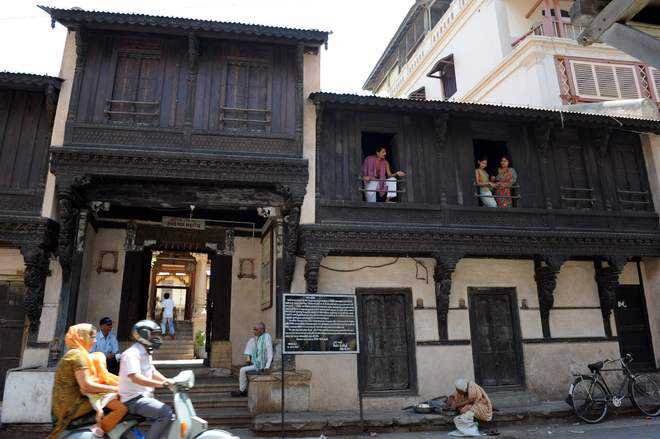
Window to a bygone era: Residents look from the windows of a carved wooden house in the walled city Photo: AFP
Kavita Kanan Chandra
The chaotic streets and meandering lanes of the old city notwithstanding, the numerous ‘pols’ or neighbourhoods with clusters of centuries old houses in the walled city of Ahmedabad is celebrated for its vibrant living heritage. It is the 606-year-old walled city, spread over 5.43 square kilometres that was founded by Ahmed Shah I in 1411 AD, has got the heritage tag. With a population of around 4 lakh and 600 ‘pols’, a heritage walk through the old quarters is a walk down the history. The recent announcement by the World Heritage Committee of Unesco bestowing the honour of India’s first World Heritage City to Ahmedabad have sent its citizens in a joyous mode and rightly so.
A fine blend of modernity and vintage glory exists in Ahmedabad. The city has had sustained development through six centuries of its existence. With its fine architecture from the Gujarat sultanate era to its present modern architecture, the city could be aptly called ‘Artistic Ahmedabad’.
The Sabarmati river that flows through the city holds a place of pride in Hindu mythology. According to a legend, on the banks of the river lived Maharishi Dadhichi, who’s said to have sacrificed his life for the devas to reclaim heaven from the asuras. He embraced death so his bones could be made into weapons to defeat the asuras. In the ancient times, the place was known as Ashavalli and then Karnavati after the Solanki ruler King Karandev I.
According to a legend, it was on the banks of Sabarmati that Ahmed Shah saw a hare chasing a dog. This unusual sight impressed him. It underlined the fearlessness of the residents of the land. This made him establish his kingdom’s capital here. He took advice from his spiritual adviser Shaikh Ahmad Khattu Ganj Baksh, a Sufi saint whose tomb was built in Sarkhej. Today, it stands as an elegant architectural structure of Sarkhej Roza. The structure is an amalgamation of Hindu craftsmanship and geometric construction pattern of Islamic architecture.
Mahatma Gandhi, too, lived here and built the Gandhi Ashram in 1915 on the banks of the Sabarmati river. It attracts visitors from all over the world to pay homage to the ‘Sabarmati ke sant’.
The best way to catch a glimpse of the cultural heritage of the city is by joining a heritage walk through the old walled city. The walk is conducted by the Amdavad Municipal Corporation (AMC) or the private House of MG (Mangaldas Girdhardas). The latter holds nightwalks from Mangaldas ni haveli to Manek Chowk (that is foodie experience for its street food). The walk culminates with the sound of more than 600-year- old tradition of drummers signalling the closing of the old city gates at 11pm.
The AMC morning walk starts with the morning aarti of the Swaminarayan temple at Kalupur and concludes at 15th century Jama Masjid, thus aptly called ‘Mandir to Masjid’ walk embracing the multi-ethnic ethos and pluralism of religions. Ambling through the labyrinths of old streets, you find densely packed traditional ‘pol’ houses and gated streets called ‘puras,’ along with Jain and Hindu temples and mosques.
The most unique feature being the ‘pols’ or neighbourhoods that house people of the same caste named after a prominent person, caste or profession. You come across Sheth ni pol, Haja Patel ni pol, Khara Kuva ni pol and numerous others. The pols had their own community wells and a very unique ‘Chabutaro’ that are ornate wooden pillars supporting bird feeder where birds flock to feed.
The walk culminates at the grand Jama Masjid, built in 1424 in Indo-saracenic style. The syncretism of Islamic, Hindu and Jain architecture is evident here. The latter aspect seen in the domes shaped like lotus flowers and pillars engraved with bells hanging on chains.
The last major mosque built in 1573 was the Sidi Saiyyed Mosque by Muzaffar Shah III. The perforated stone carving of a tree with intertwining branches looks like fine lace embroidery. The logo of IIM Ahmedabad is inspired by the jaali in the arched window called the ‘tree of life’ that has become a symbol of the city.
Other attractions
Stepwells: The Adalaj Vav at the Adalaj village (19 km from the city) is a traditional well that plunges five storeys down to an octagonal well shaft supported on eight pillars. Built in 1498 AD by Queen Rudabai, wife of Vaghela chief Virasimha, the stepwell is oblong in the south-north direction with carved Oriel windows.
The Dada Harir ni Vav, located in the Asarwa locality within the city, is also a five-storied structure with an octagonal well shaft. Constructed in 1485 by Dhai Harir, employed in Sultan Mahmud Begada palace, it has inscriptions in both Sanskrit and Arabic script.
Museums: The Calico Museum has a collection of fabrics from remote areas of India. It exhibits handcrafted textiles spanning over a period of 500 years.
The Sanskar Kendra & City Museum, designed by Le Corbusier, celebrates the living heritage of Ahmedabad. It houses the popular Kite Museum designed by Bhanu Shah.
The Auto World Museum has a private collection of more than 160 vintage cars.
The Vechaar Utensils Museum has a collection of utensils from brass, copper to modern glass ones.
Sardar Patel Museum is housed in heritage Moti Shahi Mahal built by Shah Jahan.
Bhadra Fort and Fort and Tran (three) Darwaza, built by Ahmad Shah in 1411, after he captured Karnavati has intricately carved arches and balconies.
Rani Sipri’s mosque is called ‘Masjid-e-nagina’ for its intricate carvings.
Shaking Minarets of the Sidi Bashir Mosque evoke curiosity. When one minaret of the mosque is given a jerk, the vibration causes other minaret to shake.



























